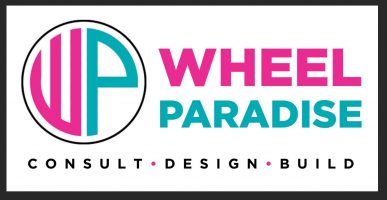Wheel Alignment and Tire Wear Patterns

Maintaining your vehicle’s performance and safety is essential, and one of the critical aspects of this is ensuring proper wheel alignment. When wheels are misaligned, it can lead to a host of problems, including uneven tire wear, reduced fuel efficiency, and compromised handling. In this article, we will delve into the relationship between wheel alignment and tire wear patterns, explaining why proper alignment is crucial for the longevity and safety of your vehicle. At Wheel Paradise, we specialize in providing top-notch wheel alignment services to keep your vehicle running smoothly.
Understanding Wheel Alignment
What is Wheel Alignment?
Wheel alignment refers to the adjustment of a vehicle’s suspension – the system that connects a vehicle to its wheels. It involves aligning the angles of the tires. The main components adjusted during wheel alignments include cambers, caster, and toe.
- Camber: The angle of the tire when viewed from the front of the vehicle. Negative camber means the top of the tires tilt inward, while positive camber means they tilt outward.
- Caster: The angle of the steering axis when viewed from the side of the vehicle. Positive caster helps with stability and steering.
- Toe: The angle of the tires when viewed from above the vehicle. Toe-in means the front of the tires are closer together, while toe-out means they are further apart.
Causes of Misalignment
Several factors can lead to wheel misalignment, including:
- Hitting Potholes: Striking potholes or curbs can knock wheels out of alignment.
- Wear and Tear: Over time, components like suspension and steering parts can wear out, affecting alignment.
- Accidents: Even minor fender benders can result in misalignment.
- Modifications: Installing new parts or altering the vehicle’s height can affect alignment.
The Impact of Misalignment on Tire Wear Patterns
Types of Tire Wear Patterns
When wheels are misaligned, it causes uneven tire wear, which can be identified through various wear patterns:
- Toe Wear: This pattern occurs when the tires are excessively toe-in or toe-out, causing the tread to wear more on one side than the other. This results in feathered or scalloped edges on the tire.
- Camber Wear: Negative or positive camber misalignment causes one side of the tire to wear more than the other. Negative camber leads to inner edge wear, while positive camber results in outer edge wear.
- Heel/Toe Wear: This pattern happens when the tire tread blocks wear unevenly, creating a sawtooth-like appearance. It’s often a result of both misalignment and improper tire rotation.
Consequences of Uneven Tire Wear
Uneven tire wear due to misalignment can lead to several problems:
- Reduced Tire Lifespan: Tires wear out faster, necessitating premature replacements.
- Poor Handling: The vehicle may pull to one side, making it difficult to steer straight.
- Decreased Fuel Efficiency: Misaligned wheels increase rolling resistance, causing the engine to work harder and consume more fuel.
- Safety Risks: Compromised handling and traction can lead to accidents, especially in adverse driving conditions.
Benefits of Proper Wheel Alignment
Extending Tire Life
By ensuring your wheels are correctly aligned, you can significantly extend the lifespan of your tires. Proper alignment distributes the load evenly across the tire tread, preventing premature wear and the need for early replacements. This highlights the importance of understanding wheel alignment and tire wear patterns.
Enhancing Vehicle Performance and Safety
Aligned wheels contribute to better handling, making your vehicle safer and more predictable on the road. It reduces the risk of accidents caused by poor steering response or sudden tire failures. Proper wheel alignment and tire wear pattern awareness ensure you can identify issues early and maintain vehicle safety.
Improving Fuel Efficiency
Proper alignment reduces rolling resistance, which means your engine doesn’t have to work as hard to move the vehicle. This translates to better fuel economy and cost savings over time. Being aware of wheel alignment and tire wear patterns helps in maintaining optimal vehicle performance.
How to Detect Misalignment
Signs to Look For
- Uneven Tire Wear: Regularly inspect your tires for uneven wear patterns.
- Vehicle Pulling: If your car pulls to one side, it’s a sign of misalignment.
- Steering Wheel Off-Center: The steering wheel should be straight when driving on a level road.
- Vibrations: Misalignment can cause vibrations in the steering wheel, especially at higher speeds.
Professional Alignment Services at Wheel Paradise
To maintain optimal alignment, it’s recommended to have your vehicle’s alignment checked regularly by a professional, especially after incidents that can cause misalignment like hitting a pothole or an accident. At Wheel Paradise, we offer comprehensive wheel alignment services to keep your vehicle in top condition. Understanding wheel alignment and tire wear patterns is crucial for maintaining your vehicle’s health.

Summing Up!
Wheel alignment plays a vital role in the overall health of your vehicle, directly impacting tire wear patterns, fuel efficiency, and safety. By understanding the importance of proper alignment and recognizing the signs of misalignment, you can ensure your vehicle remains in peak condition, providing a smooth, safe, and efficient driving experience. Don’t overlook the importance of wheel alignment – it’s a small adjustment that can make a big difference. Trust Wheel Paradise to keep your wheels aligned and your ride smooth. Contact us today to schedule your wheel alignment service. Understanding wheel alignment and tire wear patterns can save you time and money and enhance your driving experience.





